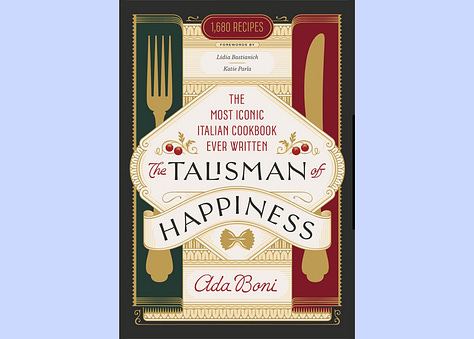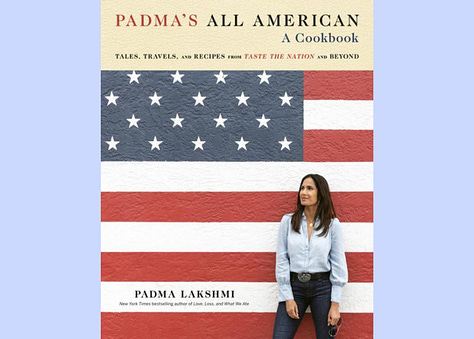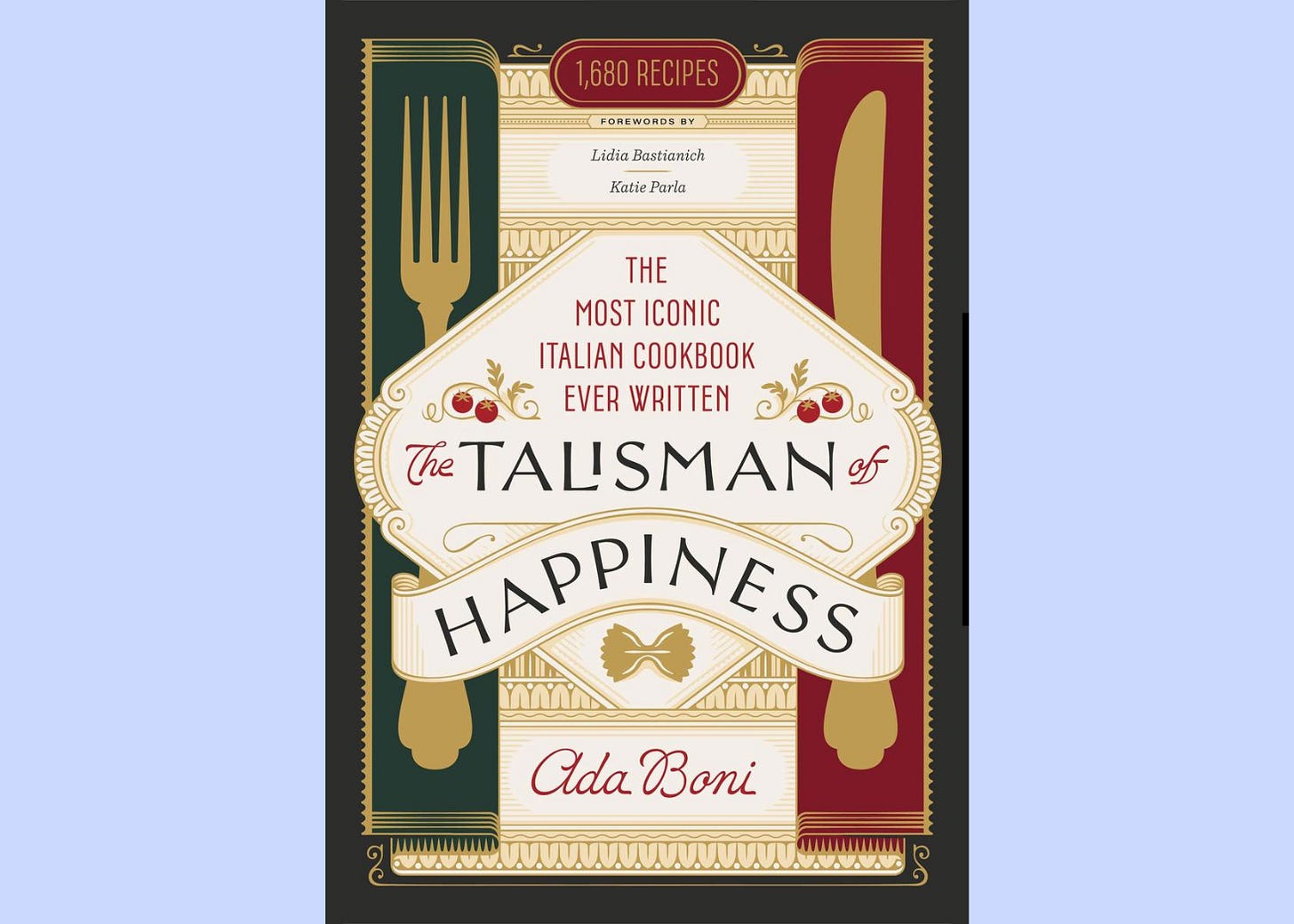Italian, All-American, and Great Galettes: What I'm Reading, November 2025
Preliminary Thoughts On My Coffee Table Tower



*The Talisman of Happiness, by Alda Boni
First published 100 years ago in Italy and never out of print, The Talisman of Happiness is traditionally as common in Italian kitchens and wedding gifts as The Joy of Cooking in the U.S. Now available for the first time in a full English translation, with nearly 1,700 recipes, the book will appeal most to confident cooks who need only a modicum of hand-holding for success.
A fascinating artifact of regional recipes across the country, from a notably limited set of ingredients, The Talisman of Happiness provides many brief (sometimes deceptively so) recipes that beginners should take on with trust in the results, and in themselves. But today’s cooks are conditioned to expect far greater detail and precision.
The ingredient list for a recipe for swordfish with tomato, for example, provides specific amounts for only three of its 13 ingredients—6 swordfish steaks, 6 tomatoes, 1 onion, versus simply “celery,” “white wine,” “parsley”—leaving the directions to call for the still-imprecise “the chopped celery,” “the crushed garlic,” “a lot of parsley.” Other recipes, such as Neapolitan skewers, call for putting skewers in the pan “to fry with plenty of oil”—but does that actually mean deep-frying? And all of the skewer lack consistency on oil temperature, citing variously “with plenty of oil,” “in a lot of hot oil,” “in plenty of very hot oil,” “in plenty of hot oil,” and and “in plenty of boiling oil.”
Maybe nervous cooks should pretend to be their great-grandmothers, cooking successfully with instructions just like this from their grandmothers.
With so many old favorites to choose from, cooks open to experimentation will find plenty of sweet spots between inspiration and frustration. Think arancini, simple fish and seafood, meatballs, meatloaf, fried eggplant, pizza, calzones, minestrone, bruschetta (calling for not the “rustic bread” we expect now but “12 slices sandwich bread”), candied orange cake, Neapolitan Easter pie, and zabaglione pudding, to name just a few, alongside many less-familiar foods worth getting to know.
*Padma’s All American: Tales, Travels, and Recipes from Taste The Nation and Beyond, by Padma Lakshmi.
Drawing on stories and recipes from Padma Lakshmi’s TV show Taste the Nation plus her own immigrant experience, Padma’s All American pushes back on anti-immigrant fury to highlight the stories of Thai, Lebanese, Gullah, Peruvian, Apache, and other cooks whose recipes make up the true “All-American” palate.
From jollof rice to sweet and sour cabbage to spicy goat bites, green papaya salad to Afghani leek and scallion dumplings to chicken with sumac and agave, Lakshmi provides deeply flavored, clear recipes that are largely doable for average cooks, though not necessarily quick.
Attractively photographed (especially if you want lots of Lakshmi photos), with heartfelt, poignant profiles of people from her show, the book makes a strong argument for breaking out of culinary ruts to appreciate all the flavors of our melting pot.
Galette! Sweet and Savory Recipes as Easy as Pie, by Rebecca Firkser
This book slipped past as much notice as it deserves when it came out in June, but what a sweet discovery now. Rebecca Firkser offers 50 recipes and many tips for these flat, free-form, rustic tarts with a pleated rim, based on one crust recipe with variations such as cocoa, cornmeal, and buckwheat. Interesting flavor combinations invite riffing, and absent the fear that true pie seems to strike in so many hearts, cooks will find galettes appearing weekly for supper or dessert.
Chapters on stone fruit; apples, pears, and citrus; berries; chocolate and other non-fruit options; winter squash and roots; nightshades and summer squash; greens and alliums; and pantry-staple galettes each offer five or six recipes.
A sweet sampling: apricot and pepita-sesame frangipane; sour cherry and Campari; pear with sumac and ginger; preserved lemon curd; minty blueberry-chamomile; figgy miso; and cocoa and toasted pecan.
On the savory side: buttered, salted radish; roasted and raw fennel; spicy eggplant Parm; scallion and asparagus with miso; sticky onion with anchovies and black olives; marinated artichoke and tomato; and chopped mushroom and kimchi. Firkser also provides useful templates for “anything goes” sweet and savory galettes.
Of course, it all starts with the crust, for which Firkser walks bakers through hand-mixing and food processor options, shaping, and extras (a crumble topping and sweet and savory toppings and sauces). She offers additional instructions for individual, muffin tin, and supersized sheet-pan galettes, as well as some formed in a tart pan to provide more structure.
One quibble: Her doughs require at least a two-hour chill before being rolled out (then back in the freezer, filled, for 10 minutes before baking). But as long as bakers work quickly and start with cold butter and ice water, it can be far quicker to immediately roll out the dough, then chill it to allow the gluten to relax, with no appreciable change in the final quality. Chilling a dough to a firm state only to wait for it to soften enough to roll out has never really made sense.
One of the tart pan options, the not-quite galette des rois, fills a crust with a delicate frangipane quickly stirred together from almond flour, eggs, butter, and amaro or other liquor. A recipe test using the suggested buckwheat crust variation produced a crisp crust with a tender rum-spiked filling nicely offset by a sprinkling of flaky salt. The tip here to place the tart on a preheated sheet pan is especially valuable for avoiding a soggy bottom (a problem usually solved for pies by prebaking the shell, but not an option for a galette).
The sweet cherry and lime galette, also in a buckwheat crust, includes a hit of grated ginger that pumped up the impact and tasted as appropriate in cool weather as warm. Once the crust is made, everything comes together quickly, goes light on the sugar (1/3 cup in the filling, with more for sprinkling on the crust, which can easily be omitted), and takes advantage of frozen fruit for year-round baking—typical for many of the recipes here.
*I haven’t tested any recipes in this book.
Disclosure: I am an affiliate of Bookshop.org, which supports independent booksellers, and I will earn a commission if you click through and make a purchase on any of the titles above.




